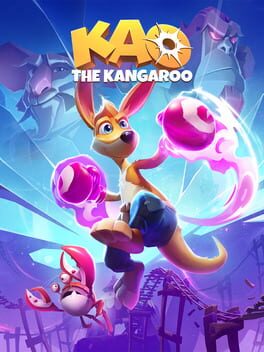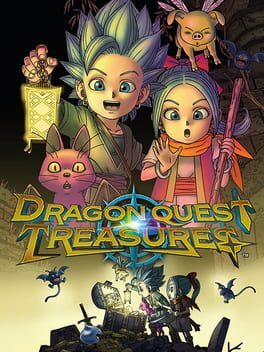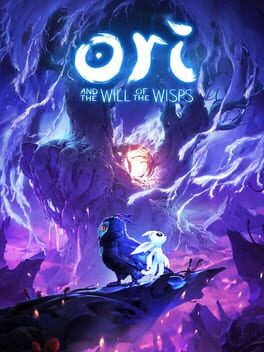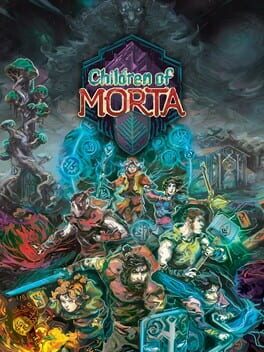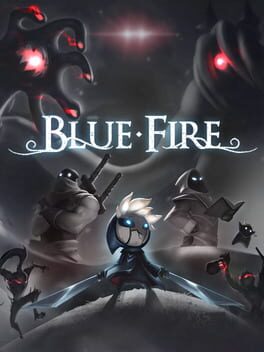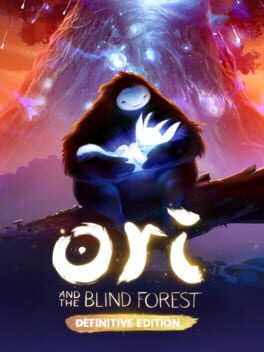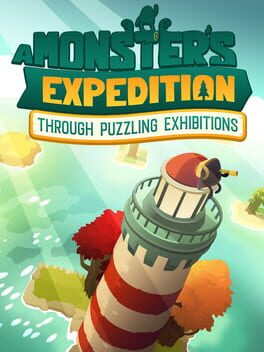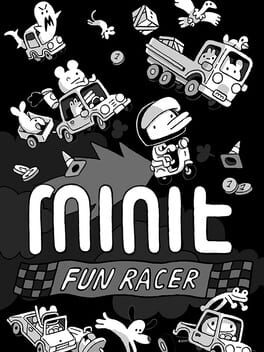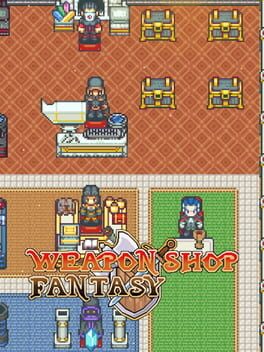TheMediaDiorama
2022
A refreshing throwback to 3D platformers of old that may not be an entire knockout, but a worthy punch. Fun levels, vibrant worlds, loads of collectibles and voice acting that can be summed up in one word: cringey. The fact this franchise is still going is bafflingly awesome. Yet, there’s a lack of polish (several visual/audio glitches) amidst the undercooked combat that becomes super frustrating for achievement hunters when the trophies themselves are often glitched…
2020
A fine metroidvania with a sizeable and distinct world to explore. Some interesting navigational mechanics, such as spawning a bubble that allows you to reach higher places. The dungeon filled with one-hit death spikes however, not fun. The platforming isn’t precise enough to offer that degree of, well, precision.
2022
A purrrr-fectly short adventure in a dilapidated city filled with buzzing robots as you, a stray feline, must jump, meow and solve stealth-based environmental puzzles to free this trapped settlement of its own imprisonment. It’s perhaps too short and linear for the price tag, but the world-building is absolutely captivating. Loved it!
Cute, creative level design, well-hidden collectibles and deceptively easy gameplay that becomes rather challenging towards the last fifth of the main game (especially collecting everything). An absurd amount of paper crafting polish from Nintendo here. The bosses were far too simple though and the music has practically no variety and plays the same level song for a good 20 levels…
‘Dragon Quest Monsters Joker’ set in the ‘Dragon Quest XI’ universe (main characters specifically…) with a hint of ‘Dragon Quest Rocket Slime’ and some ‘Ni No Kuni II’ gameplay loops. It’s a smorgasbord of JRPG wholesomeness that really relies on your thirst for treasure hunting. There are quests, and there’s a vague story. But ultimately you’re scouring these five huge dragon continents waiting for your party monsters to tell you that treasure is nearby. It’s so simple, yet so addicting. Exploration is pretty much perfect here, just a shame the combat isn’t and becomes super frustrating when the game throws boss fights at you in the latter half. So many ideas, some undercooked, some overbaked and some are just delicious. This is one for the Dragon Quest fans!
2021
Ori and the Will of the Wisps whimsically consumes the forestry strands of its predecessor and grows a new majestic world that manages to improve on every aspect that made its antecedent an acclaimed piece of art.
WHAT I LIKED:
+ Light versus dark. Life versus death. Growth versus decay. Moon Studios wrote a renowned tale of natural melancholy when creating Blind Forest that made players break down in tears within the first ten minutes. Obviously, this thematic presence would continue into its sequel, and it is relentless. Whilst the glimmer of hope shines throughout Ori's second quest into saving a new forest, with the assistance of Kuro's last baby owl Ku, it is not a happy tale. Not. At. All. But that's the beauty of Will of the Wisp's narrative. It never sugarcoats the natural order of life. It flourishes when it is at its most heartless, but consistently makes an impression upon the player. When those final ten minutes play, your heart will either be empty or flooded with salty tears. Masterful direction!
+ Corruption and decay has withered the forest. Much like Nibel, Niwen centralises itself around a colossal tree, this time a willow. However a core concept within this sequel's art design is the alteration the growing decay makes on Niwen's luscious areas. The polluted waters of The Wellspring. The eternal darkness of Mouldwood Depths. The degradation of Silent Woods. Ori, being tasked in finding all five wisps to reignite the willow's spirit light, can restore Niwen to its former flourishing state once obtaining each of the wisps. For example granting Mouldwood Depths an abundance of light once more. These small details grant Niwen a brand new life of its own as the journey progresses. Yes, the art direction is just as masterful as Blind Forest. And yes, it is one of the most gorgeous experiences to be had. But these changes in geography and natural state enhance the Metroidvania style that Moon Studios have lovingly embraced. Niwen truly felt interconnected.
+ Slash through the tainted wildlife. Unlike Blind Forest which predominantly focused on precision platforming over combat, Will of the Wisp progresses the base gameplay mechanics even further by fairly balancing the two styles. Ori is equipped with an array of abilities, with three being assigned at any one time, that grant him new combat and traversal powers. Launching speared projectiles at enemies. Smashing the ground and pulverising the indigenous fauna. Each of these abilities can be upgraded and can be switched out at any time. This grants the player further strategy when encountering a combat shrine and/or a tricky path of traps.
+ Hollow Knight makes an impression once again. "Soul Links" and the previous sequential upgrade system have been abandoned, with Moon Studios adopting the charm system that Team Cherry's masterpiece Hollow Knight had strategically employed. Ori can now attach several shards to him that gift him with several bonuses and curses, such as increase in defence or triple jumping. The gimmick here is that Ori can only have a a certain number of shards attached to him at any time, therefore the player must strategically grant Ori the appropriate shards for the appropriate situation. Several shards, and the total capacity, can be upgraded to further Ori's skills when encountering the dangers of Niwen.
+ The beasts of Niwen will strike Ori down. The trial and error escape sequences that Blind Forest haphazardly introduced have been dialled back somewhat in this sequel. Sure, they do exist, but they are far more forgiving. Instead, thanks to the focus on combat, boss battles make an appearance. And boy oh boy are they tough! A colossal arachnid lurking in the darkness. A corrupted giant toad. An enormous sandworm. There's plenty of beasty boys to test the player's combat initiatives, and they all have multiple phases to them.
+ Fear not though, as there are plenty of collectibles scattered throughout Niwen that can assist in besting those beasts. From energy and life cells to hidden shards, every collectible is necessary to make Ori as strong as possible. Another new addition to Will of the Wisp's is a central village that hosts all of the different vendors needed to upgrade Ori's abilities. Gorlek Ores are also secretly positioned throughout Niwen and are used to help rebuild the glades. There's also an abundance of sidequests that will reward Ori handsomely. So if you ever find yourself stuck against a boss battle, there's plenty the needs to be done and explored in the forest of Niwen.
+ A symphony of art. Composer Gareth Coker certainly made an impression with Blind Forest's composition, but he outdid himself with this game's soundtrack. It is unequivocally beautiful. Every single facet of Niwen's sprawling landscapes were accompanied by a score that supplied even more life to the artistic visuals. From the gentle violin strings of Mouldwood Depths to the grandiose tapestry found in Willow's End. This soundtrack needs everyone's attention!
+ Will of the Wisp is bigger, better and braver with its storytelling, world-building and integral gameplay. Everything a sequel should do!
WHAT I DISLIKED:
- As seen on the poster and the vastly detailed promotional material, Ori is accompanied by an friendly owl named Ku. From the introductory prologue and a segment in the Silent Woods, the player can control both Ori and Ku together as they traverse the desolate intricacies of this newly discovered forest. Ku can glide, flap her wings on the ground and has an increased walking speed. The only issue is, after a not-so minor plot detail unveils itself, this partnership ceases to exist and the player can no longer control both Ori and Ku. Considering the possibilities of new traversal mechanics, this felt like a wasted opportunity to add some more flavour to Ori's traditional gameplay style. Had Moon Studios extended the Silent Woods segment, and/or chose to include Ku in more of Ori's initial journey before their separation, Will of the Wisp's may have been the perfect varied Metroidvania title.
VERDICT:
9/10 Gorlek Ores
WHAT I LIKED:
+ Light versus dark. Life versus death. Growth versus decay. Moon Studios wrote a renowned tale of natural melancholy when creating Blind Forest that made players break down in tears within the first ten minutes. Obviously, this thematic presence would continue into its sequel, and it is relentless. Whilst the glimmer of hope shines throughout Ori's second quest into saving a new forest, with the assistance of Kuro's last baby owl Ku, it is not a happy tale. Not. At. All. But that's the beauty of Will of the Wisp's narrative. It never sugarcoats the natural order of life. It flourishes when it is at its most heartless, but consistently makes an impression upon the player. When those final ten minutes play, your heart will either be empty or flooded with salty tears. Masterful direction!
+ Corruption and decay has withered the forest. Much like Nibel, Niwen centralises itself around a colossal tree, this time a willow. However a core concept within this sequel's art design is the alteration the growing decay makes on Niwen's luscious areas. The polluted waters of The Wellspring. The eternal darkness of Mouldwood Depths. The degradation of Silent Woods. Ori, being tasked in finding all five wisps to reignite the willow's spirit light, can restore Niwen to its former flourishing state once obtaining each of the wisps. For example granting Mouldwood Depths an abundance of light once more. These small details grant Niwen a brand new life of its own as the journey progresses. Yes, the art direction is just as masterful as Blind Forest. And yes, it is one of the most gorgeous experiences to be had. But these changes in geography and natural state enhance the Metroidvania style that Moon Studios have lovingly embraced. Niwen truly felt interconnected.
+ Slash through the tainted wildlife. Unlike Blind Forest which predominantly focused on precision platforming over combat, Will of the Wisp progresses the base gameplay mechanics even further by fairly balancing the two styles. Ori is equipped with an array of abilities, with three being assigned at any one time, that grant him new combat and traversal powers. Launching speared projectiles at enemies. Smashing the ground and pulverising the indigenous fauna. Each of these abilities can be upgraded and can be switched out at any time. This grants the player further strategy when encountering a combat shrine and/or a tricky path of traps.
+ Hollow Knight makes an impression once again. "Soul Links" and the previous sequential upgrade system have been abandoned, with Moon Studios adopting the charm system that Team Cherry's masterpiece Hollow Knight had strategically employed. Ori can now attach several shards to him that gift him with several bonuses and curses, such as increase in defence or triple jumping. The gimmick here is that Ori can only have a a certain number of shards attached to him at any time, therefore the player must strategically grant Ori the appropriate shards for the appropriate situation. Several shards, and the total capacity, can be upgraded to further Ori's skills when encountering the dangers of Niwen.
+ The beasts of Niwen will strike Ori down. The trial and error escape sequences that Blind Forest haphazardly introduced have been dialled back somewhat in this sequel. Sure, they do exist, but they are far more forgiving. Instead, thanks to the focus on combat, boss battles make an appearance. And boy oh boy are they tough! A colossal arachnid lurking in the darkness. A corrupted giant toad. An enormous sandworm. There's plenty of beasty boys to test the player's combat initiatives, and they all have multiple phases to them.
+ Fear not though, as there are plenty of collectibles scattered throughout Niwen that can assist in besting those beasts. From energy and life cells to hidden shards, every collectible is necessary to make Ori as strong as possible. Another new addition to Will of the Wisp's is a central village that hosts all of the different vendors needed to upgrade Ori's abilities. Gorlek Ores are also secretly positioned throughout Niwen and are used to help rebuild the glades. There's also an abundance of sidequests that will reward Ori handsomely. So if you ever find yourself stuck against a boss battle, there's plenty the needs to be done and explored in the forest of Niwen.
+ A symphony of art. Composer Gareth Coker certainly made an impression with Blind Forest's composition, but he outdid himself with this game's soundtrack. It is unequivocally beautiful. Every single facet of Niwen's sprawling landscapes were accompanied by a score that supplied even more life to the artistic visuals. From the gentle violin strings of Mouldwood Depths to the grandiose tapestry found in Willow's End. This soundtrack needs everyone's attention!
+ Will of the Wisp is bigger, better and braver with its storytelling, world-building and integral gameplay. Everything a sequel should do!
WHAT I DISLIKED:
- As seen on the poster and the vastly detailed promotional material, Ori is accompanied by an friendly owl named Ku. From the introductory prologue and a segment in the Silent Woods, the player can control both Ori and Ku together as they traverse the desolate intricacies of this newly discovered forest. Ku can glide, flap her wings on the ground and has an increased walking speed. The only issue is, after a not-so minor plot detail unveils itself, this partnership ceases to exist and the player can no longer control both Ori and Ku. Considering the possibilities of new traversal mechanics, this felt like a wasted opportunity to add some more flavour to Ori's traditional gameplay style. Had Moon Studios extended the Silent Woods segment, and/or chose to include Ku in more of Ori's initial journey before their separation, Will of the Wisp's may have been the perfect varied Metroidvania title.
VERDICT:
9/10 Gorlek Ores
2021
Starting off as a warrior with just a puny whip and then eventually unlocking a queen of chaos who vaporises thousands of enemies within seconds. Yeah, 100%-ing this game was an absolute BLAST! So many unlockables, so many “ohhh just one more go” moments and so so so many flashing lights shrouding my screen in utter carnage. Sure, the presentation is somewhat clunky (particularly the menus), but who cares. You feel powerful. And power is all you want in Vampire Survivors!
2019
A roguelike hack-and-slash centred around a loveable family known as the Bergsons. Lots of different playable characters representing each member of the family, from sword-wielding melee tanks to flame-producing ranged apprentices, so there’s a role for every sort of player. Having said that, ranged absolutely overwhelmed melee characters for sure. The bosses in particular favoured a ranged attacking stance. The narrative is cute with a few minor revelations, but it’s no ‘Hades’ (is anything though?). Powerful charms and relics, varied skills to upgrade. Overall, a tight roguelike with memorable characters.
2021
Floating castle of metroidvanian labyrinthine design, ‘Hollow Knight’ presentation in terms of bleakness and slick platforming, ‘Ocarina of Time’ enemy lock-on mechanism for dangerous sword slashing aerial manoeuvring. Yeah, Blue Fire was a short blast! Would’ve loved more dungeons, more variety in voids (think platform-based shrines from ‘Breath of the Wild’) and harder boss fights. But when jumping, gliding and wall running is this effortless, you just want more!
Ori and the Blind Forest magically uplifts its gorgeous interconnected wooded world of majestic flora and hostile fauna through a viscerally melancholic narrative that elevates this sublime Metroidvania high above Nibel's leafy canopies.
WHAT I LIKED:
+ Pixar's helium-fuelled 'Up' is infamous for its emotionally affecting initial ten minutes. Well, Moon Studios attempt to match that saddening experience through its prologue of Ori's upbringing with Naru. You. Will. Cry. If no tears are shed, the eyes will undoubtedly be moist as the player unexpectedly welcomes the sorrowful tone beneath the beautiful art direction that truly powers the narrative of Ori's journey. A cataclysmic event results in the forest withering into decay, with Ori tasked in reviving the Spirit Tree by recovering the forest's light. There's death. There's destruction. But much like the Circle of Life, a concept Moon Studios was heavily influenced by, there's life. And the Blind Forest wholesomely attests to this concept through a visually stunning and emotional story that is just as important as the gameplay on offer.
+ Nibel has a life of its own. The rural world of Nibel, ranging from the serene marshlands of Thornfelt Swamp to the blustery Ghibli-inspired Valley of the Wind, has a plethora of characteristics that compliment the traditional aspects of a Metroidvania. Exploration is vital, with Ori equipped with a sprawling interconnected map that allows the player to become accustomed to the local geography as well as seek out nearby secrets. Locating Spirit Wells to regain life and energy as well as indicating fast travel points. It may seem beautifully daunting initially, but once the player explores Nibel and head out to obtain each of the three elements, the world gradually ingrains itself into the mind. It is absurdly difficult to sublimely transition between areas and still make the change look natural, however Moon Studios did that with an abundance of confidence, truly granting Nibel the life it requires.
+ Jumping between branches, diving into cold waters and moving rocks to unlock ancient doors are all traditional aspects to the Metroidvania genre. Blind Forest certainly uses the floral environment to generate challenges, both from a combat and platforming perspective, however the sole standout that differentiates this game from others within the saturated genre is the use of "Soul Links". Using Ori's energy to create, these energy-infused beams of light serve as checkpoints throughout the game. The difficulty is implemented by the low abundance of energy crystals needed to allow Ori to create these "Soul Links", therefore invoking a strategy as to where and when the player should create these checkpoints. The platforming is tough, so activating a "Soul Link" after completing a tricky area would be advisable, as the player is more than likely to accidentally jump at the wrong time and allow Ori to get impaled by a thorn...
+ Ori starts off as a fragile guardian spirit, but will soon evolve into a speedy, combative, free-running beast through the use of an ability tree system. Slaying enemies, destroying certain flora and locating those valuable spirit containers will grant Ori the opportunity to gain new skills based on three distinct categories. Every single skill is deemed useful, either for traversal or combat enhancements, inciting the player to choose wisely before venturing further into the dangers that Nibel succinctly hides away.
+ Nibel is brought to life through an ornate art direction that can only be surmised in one word: Beguiling. There's no other way to describe Blind Forest. The creative team at Moon Studios have produced one of the most gorgeous gaming experiences ever, often surpassing the vast majority of AAA titles. From the 3D animated character models populating the vibrant water-coloured backdrops to the softly epic score that is teeming with life. There is not a single line, colour or detail out of place!
+ Ori's journey to save Nibel is a short quest. Fortunately it never outstays it welcome, with a plethora of collectibles to be found and an array of difficulties added in the Definitive Edition which all increase the replay value. The "One Life" difficulty is, to be bluntly, absurd mostly due to the only complaint that could be found...
WHAT I DISLIKED:
- ...the escape sequences. Ori never really faces off against a boss, mostly due to the focus on precise platforming rather than aggressive combat. Instead, after each element is obtained, Ori must flee from a threat that seeks to end him. This could be rapidly rising waters with the player tasked in ascending a tower before Ori drowns, or a ferocious owl swooping in every five seconds. These sequences generate an artificial difficulty that pushes Ori's newfound abilities to generate tension and pressure, more so than having the player moving around normally. The problem is with the absurd "trial and error" approach and the lack of checkpoints that ultimately incites repetition in order for the player to learn the traps and obstacles before moving on. Repetition is the antithesis of fun. Whilst the tension is ramped up, the change in pace is not welcomed and provokes several unnecessary rage-inducing moments in what is otherwise a near-perfect game.
VERDICT:
8/10 ancestral trees
WHAT I LIKED:
+ Pixar's helium-fuelled 'Up' is infamous for its emotionally affecting initial ten minutes. Well, Moon Studios attempt to match that saddening experience through its prologue of Ori's upbringing with Naru. You. Will. Cry. If no tears are shed, the eyes will undoubtedly be moist as the player unexpectedly welcomes the sorrowful tone beneath the beautiful art direction that truly powers the narrative of Ori's journey. A cataclysmic event results in the forest withering into decay, with Ori tasked in reviving the Spirit Tree by recovering the forest's light. There's death. There's destruction. But much like the Circle of Life, a concept Moon Studios was heavily influenced by, there's life. And the Blind Forest wholesomely attests to this concept through a visually stunning and emotional story that is just as important as the gameplay on offer.
+ Nibel has a life of its own. The rural world of Nibel, ranging from the serene marshlands of Thornfelt Swamp to the blustery Ghibli-inspired Valley of the Wind, has a plethora of characteristics that compliment the traditional aspects of a Metroidvania. Exploration is vital, with Ori equipped with a sprawling interconnected map that allows the player to become accustomed to the local geography as well as seek out nearby secrets. Locating Spirit Wells to regain life and energy as well as indicating fast travel points. It may seem beautifully daunting initially, but once the player explores Nibel and head out to obtain each of the three elements, the world gradually ingrains itself into the mind. It is absurdly difficult to sublimely transition between areas and still make the change look natural, however Moon Studios did that with an abundance of confidence, truly granting Nibel the life it requires.
+ Jumping between branches, diving into cold waters and moving rocks to unlock ancient doors are all traditional aspects to the Metroidvania genre. Blind Forest certainly uses the floral environment to generate challenges, both from a combat and platforming perspective, however the sole standout that differentiates this game from others within the saturated genre is the use of "Soul Links". Using Ori's energy to create, these energy-infused beams of light serve as checkpoints throughout the game. The difficulty is implemented by the low abundance of energy crystals needed to allow Ori to create these "Soul Links", therefore invoking a strategy as to where and when the player should create these checkpoints. The platforming is tough, so activating a "Soul Link" after completing a tricky area would be advisable, as the player is more than likely to accidentally jump at the wrong time and allow Ori to get impaled by a thorn...
+ Ori starts off as a fragile guardian spirit, but will soon evolve into a speedy, combative, free-running beast through the use of an ability tree system. Slaying enemies, destroying certain flora and locating those valuable spirit containers will grant Ori the opportunity to gain new skills based on three distinct categories. Every single skill is deemed useful, either for traversal or combat enhancements, inciting the player to choose wisely before venturing further into the dangers that Nibel succinctly hides away.
+ Nibel is brought to life through an ornate art direction that can only be surmised in one word: Beguiling. There's no other way to describe Blind Forest. The creative team at Moon Studios have produced one of the most gorgeous gaming experiences ever, often surpassing the vast majority of AAA titles. From the 3D animated character models populating the vibrant water-coloured backdrops to the softly epic score that is teeming with life. There is not a single line, colour or detail out of place!
+ Ori's journey to save Nibel is a short quest. Fortunately it never outstays it welcome, with a plethora of collectibles to be found and an array of difficulties added in the Definitive Edition which all increase the replay value. The "One Life" difficulty is, to be bluntly, absurd mostly due to the only complaint that could be found...
WHAT I DISLIKED:
- ...the escape sequences. Ori never really faces off against a boss, mostly due to the focus on precise platforming rather than aggressive combat. Instead, after each element is obtained, Ori must flee from a threat that seeks to end him. This could be rapidly rising waters with the player tasked in ascending a tower before Ori drowns, or a ferocious owl swooping in every five seconds. These sequences generate an artificial difficulty that pushes Ori's newfound abilities to generate tension and pressure, more so than having the player moving around normally. The problem is with the absurd "trial and error" approach and the lack of checkpoints that ultimately incites repetition in order for the player to learn the traps and obstacles before moving on. Repetition is the antithesis of fun. Whilst the tension is ramped up, the change in pace is not welcomed and provokes several unnecessary rage-inducing moments in what is otherwise a near-perfect game.
VERDICT:
8/10 ancestral trees
Moving logs around to jump from one island to the other has never been so relaxing…and yet so perplexing! Some great brain-teasing logic puzzles that get more and more challenging as you explore the “open” archipelago, seamlessly integrating new strategies that will make you approach the puzzles differently. Many of the puzzle variants are repeated and some of the islands feel like filler, but the puzzling experiencing is incredibly polished. You’ll start your adventure simply knocking down one tree…and finish it rolling logs on top of rocks, making rafts and precariously figuring out each placement.
2022
I’m baffled by the good reviews, I truly truly am…
An open-world Sonic game SHOULD work. Running across sprawling horizons collecting rings (and not stat seeds that provide little to no increase, machine gears, vault keys, memory heart things and little rock statues…), rolling around at the speed of sound. But, Frontiers is not it.
The game is monumentally broken as the developers thought to throw as much “stuff” in as possible to see what sticks, to the point that the experience is beyond infuriating. The vault levels were recycled layouts from other 3D Sonic games, yet way more clunky. The fishing mini-game was out of place and tedious. The riff on map revealing, while slightly more intuitive that climbing a tower and simply looking out, never felt rewarding with random patches of the map uncovering nothing useful. The technical issues (yes, the pop-in is inexcusable) made most of the platforming frustrating.
But the combat…
The combat is possibly the worst I’ve ever experienced. Looping around enemies and mashing buttons with zero strategy. That was all tolerable, until the fight with Giganto. Quite possibly the worst boss fight ever? To the point where after multiple attempts, I decided to put down my controller and say “yeah…I’ve had enough”. Parrying is inconsistent, with the boss randomly flailing its arms thinking you’re in the hit box detection area. So imagine my aggravation when parrying was pretty much mandatory before your Super Sonic ring timer dials down to zero and you have to repeat the whole ordeal again. You can’t integrate combat-heavy boss fights when the combat itself is diabolically broken. And I’ve seen many compare the combos to ‘Devil May Cry’ and ‘Bayonetta’…you having a laugh?
So yeah, ashamed to say I didn’t make it past the first boss fight. The game was THAT unplayable for me. But hey, at least it’s still better than Sonic ‘06…
An open-world Sonic game SHOULD work. Running across sprawling horizons collecting rings (and not stat seeds that provide little to no increase, machine gears, vault keys, memory heart things and little rock statues…), rolling around at the speed of sound. But, Frontiers is not it.
The game is monumentally broken as the developers thought to throw as much “stuff” in as possible to see what sticks, to the point that the experience is beyond infuriating. The vault levels were recycled layouts from other 3D Sonic games, yet way more clunky. The fishing mini-game was out of place and tedious. The riff on map revealing, while slightly more intuitive that climbing a tower and simply looking out, never felt rewarding with random patches of the map uncovering nothing useful. The technical issues (yes, the pop-in is inexcusable) made most of the platforming frustrating.
But the combat…
The combat is possibly the worst I’ve ever experienced. Looping around enemies and mashing buttons with zero strategy. That was all tolerable, until the fight with Giganto. Quite possibly the worst boss fight ever? To the point where after multiple attempts, I decided to put down my controller and say “yeah…I’ve had enough”. Parrying is inconsistent, with the boss randomly flailing its arms thinking you’re in the hit box detection area. So imagine my aggravation when parrying was pretty much mandatory before your Super Sonic ring timer dials down to zero and you have to repeat the whole ordeal again. You can’t integrate combat-heavy boss fights when the combat itself is diabolically broken. And I’ve seen many compare the combos to ‘Devil May Cry’ and ‘Bayonetta’…you having a laugh?
So yeah, ashamed to say I didn’t make it past the first boss fight. The game was THAT unplayable for me. But hey, at least it’s still better than Sonic ‘06…
2021
2017
